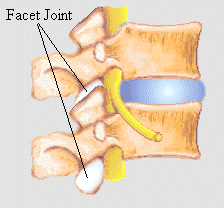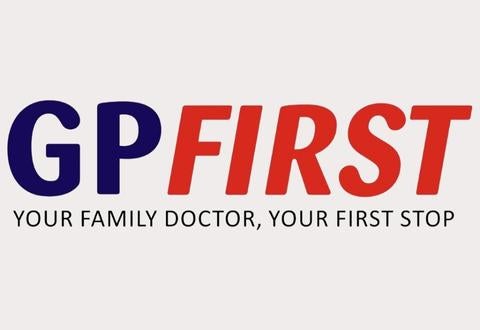What is - Facet Joint Syndrome and Treatment
 What are Facet Joints?
What are Facet Joints?
Facet joints are the joints between each portion of the backbone (vertebrae), which are present on both sides of the spine.
What is Facet Joint Syndrome?
When back pain or neck pain is caused by a pathology or problem in the facet joint, it is termed, facet joint syndrome.
What does Facet Joint Syndrome feel like?
Activities that cause pressure on the facet joints will make the neck or back pain worse. These activities include leaning backwards and "extending" the neck or lower back as well as twisting at the waist.
Pain arising from the facet joints is usually at the level of the affected facet joint. Occasionally the pain may radiate to other areas. If the lower back facets are diseased, pain may radiate to buttocks or thighs. If the neck facets are involved pain may radiate to head, upper back and shoulders.
Facet Joint Syndrome and Treatment - Causes and Risk Factors
What causes Facet Joint Syndrome?
The facet joints may be diseased from injury, repetitive movements or degeneration due to age and activity. If the intervertebral disc between each vertebra is damaged, the cushioning effect of the disc is lost. This may cause more stress on the facet joints at that level. Degeneration of the facet joints may then proceed.
How we use our body can result in problems with the facet joints. Overweight, poor posture, bending from the back, improper lifting, poor rest positions, and prolonged sitting in poorly designed chairs can all cause stress on the facet joints.
Diagnosis of Facet Joint Syndrome and Treatment
How is Facet Joint Syndrome diagnosed?
A good medical history and a physical examination by a trained physician will usually clinch the diagnosis. X-rays of the back and neck may help to rule out degenerative changes in the facet joints or disc. Depending on the severity, MRI and CT scans may be ordered by the physician.
Pain physicians at the Pain Management Centre can give an injection of local anaesthetic into the facet joints with continuous X-ray (fluoroscopic) guidance. This is a very accurate method for diagnosing facet joint irritation. If the patient obtains relief, further treatment of the facet joints may proceed with greater confidence.
Treatment for Facet Joint Syndrome and Treatment
How is Facet Joint Syndrome treated?
Treatment may involve physical therapy (joint mobilization or manipulation), exercise, and education on good spine posture. Pain may initially worsen after physical therapy before improving as the stiff joints are mobilised. Anti-inflammatory medications and pain medications will be prescribed. Topical non-steroidal anti-inflammatory preparations may also be prescribed. Physiotherapy referral for controlled exercises and heat/ultrasound treatment will also be offered. Activity modification may be advised.
At the SGH Pain Management Centre, there is the additional option of acupuncture as this can also help alleviate symptoms.
In some cases these conservative treatment modalities may not be satisfactory. At the Pain Management Centre, pain specialists can do facet joint injections with very small doses of steroids. Alternatively, they can also inject the nerves to the facet joint (medial branch nerve blocks) and block the pain messages from these nerves that surround the affected facet joints.
Radiofrequency ablation of these nerves using a special machine we have provides longer relief.
What happens during the procedure?The patient is assessed for other medical problems and contraindications for the procedure. The procedure is explained to the patient and a formal consent is obtained. The patient needs to fast for 6 hrs before the procedure but plain water is allowed up to 2 hrs before the procedure.
The patient is taken into an operating room at the Pain Management Centre and positioned prone on the stomach. Using x-ray guidance, the relevant facet joint or nerve is localised accurately. Sedation may be given if necessary. The skin on the back is cleaned with a disinfectant. Following this the physician numbs a small area of skin with numbing medicine (local anaesthetic). Then a small needle is passed close to the nerve/joint under x-ray guidance. Once the needles are in the correct position, a small mixture of numbing medicine (local anaesthetic) and anti-inflammatory steroid is injected. One or several joints may be blocked. There is very minimal pain and discomfort. The procedure will take 15-30 minutes.
If radiofrequency ablation is performed, the procedure is similar but will take longer. A small electrical current will pass through the needle once it is next to the correct nerve. A mild tingling sensation will be felt. Once the needle is in the correct place, the radiofrequency machine will heat the nerve. A strange sensation may be felt in the area corresponding to usual pain but it should not be painful. The procedure may be repeated for 2 or more nerves.
Sometimes these procedures may cause an increase in pain in the following days before a beneficial effect is felt. This is normal and the patient should rest and take pain medications. When pain relief is felt, the patient should take the opportunity to gradually increase activity. The physical therapist can guide in this.
After the procedure, you will be monitored to ensure safety before discharge in about 1 to 2 hours.
Many individuals with facet joint syndrome will recover and return to normal activities. Proper posture, proper body mechanics, and certain exercises should be maintained in order to ensure ongoing back health. Elderly patients and those with severe disease may get only partial benefit with joint or nerve injections and medications may need to be continued but at much lower doses. Injections may be repeated safely if required after an acceptable interval.
Your pain physicians and physical therapists that deal with people with facet joint syndrome can help outline an individualized treatment program.
Contributed by
The information provided is not intended as medical advice. Terms of use. Information provided by SingHealth.
Condition Treated At
Department
Anaesthesia & Surgical Intensive Care
Department
Pain Management Centre
Department
Physiotherapy
Get to know our doctors at SingHealth Hospitals in Singapore.
Get to know our doctors at SingHealth Hospitals in Singapore. here.



















